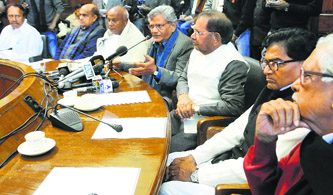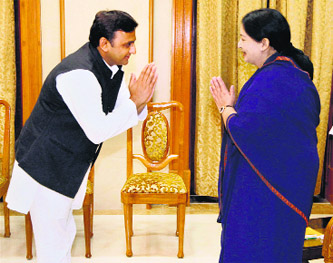| |
Polls 2014
Will a third alternative work?
By KV Prasad
Power has mostly remained with the two national parties — the Congress and BJP — even as they headed a coalition government at the Centre. The ‘third front’ idea has been around for long. Now, the Left and regional parties are regrouping to give it a definite shape. Will it fire the voter’s imagination?

AIADMK leader Thambi Durai
(left), JD (S) veteran leader HD Deve Gowda (3rd from left),
senior CPI (M) leader Sitaram Yechury, JD (U) president Sharad
Yadav, SP leader Ram Gopal Yadav and Gurudas Dasgupta from the CPI
at a press conference after the ‘third front’ meeting at
Parliament House in New Delhi on Wednesday. Tribune Photo: Mukesh
Aggarwal
|
The
country is getting ready
to elect a new Lok Sabha. Even though a formal announcement of the
schedule by the Election Commission is yet to be made, political
parties have launched campaigns in the run-up to the declaration of
the dates. The term of the 15th Lok Sabha ends on May 31 this year and
the new House will have to be elected before that.For the past two
decades, the people have given a fractured mandate. Barring 1991-1996
when Congress under PV Narasimha Rao first ran a minority government
that acquired majority in due course, the country has had a coalition
regime at the Centre since 1996. A major shift in the direction came
after 1998 when the leadership of a coalition government rested either
with the BJP or the Congress, a move suggesting that the country is
moving towards a bipartisan arrangement. Contesting this idea, the
Left along with a clutch of regional parties are coming together with
the hope to capture the imagination of the people who are clearly not
comfortable with either of these two national parties.
The give and
take

AIADMK chief Jayalalithaa, keen on ‘third front’, with UP CM Akhilesh Yadav. PTI file photo
|
Tempered by experience and learning from reversals in electoral
battles of the past, parties outside the Congress and BJP fold are
working on a plan to project a "third alternative" at the
national level, which is an arrangement without any formal agreement
on seat sharing or electoral pacts. There could be some understanding
in a few places. Articulating the concept, CPM general secretary
Prakash Karat says: "We will evolve a common platform and pool in
our independent strengths. We feel that the Congress is losing ground
and will not be able to fight the BJP. So there is a need for a
non-Congress, non-BJP alternative." The first in the series was
a national-level convention in Delhi on October 30 which was attended
by 14 parties, including the four Left parties, socialists and
regional parties. Of these, the Communist Party of India, CPI
(Marxist), All India Forward Bloc, Revolutionary Socialist Party, Asom
Gana Parishad, All India Anna Dravida Munnetra Kazghagam, Biju Janata
Dal, Samajwadi Party, Janata Dal (United), Janata Dal (Secular) and
Jharkhand Vikas Morcha have now formed a "bloc" in
Parliament to coordinate a strategy in the resumed winter session that
will end on February 21. The Delhi convention was also attended by
Manpreet Badal’s Peoples Party of Punjab, Prakash Ambedkar’s
faction of the Republican Party of India, and the Nationalist Congress
Party, which is with the Congress-led UPA.
Not a threat The Left
parties are the catalyst in forming an alternative, but unlike the
previous experiment, all those who are in talks are wary of labelling
it as the "third front". Taking a leaf from the 2009
results, when the four Left parties, along with the Telugu Desam
Party, BJD and JD (S), could not get the requisite strength, the
tactics have been changed this time. "Each party is strong in
their respective states — the AIADMK in Tamil Nadu, JD (U) in Bihar,
BJD in Orissa, JD (S) in Karnataka and TDP in Andhra Pradesh. The Left
parties are the common link between these parties and are in
conversation with one another," says Karat. The inherit
contradiction of contesting against each other is not a concern since
these parties do not have the potential to damage the interest of the
others in states where the regional party is strong. For instance,
even through the Left may contest a few seats in Uttar Pradesh, it
lacks the potential to upset the SP. Barring Tamil Nadu, where the
AIADMK has renewed it electoral pact with the CPI and CPM, there is no
formal agreement in place in any other state. In Bihar, the Left
parties are in discussions with the JD (U) for seat sharing but that
is as far as it goes.
Trust issues Ironically, while Mulayam Singh
Yadav is also pushing for a national alternative, the SP is not
willing to concede any seat in the Lok Sabha to its allies. It does
not end here. The trust that the Left parties place in Mulayam Yadav
cannot be explained when judged against the actions of the SP chief
who emerged as the chief wrecker on previous occasions. The SP chief
walked out of the People's Front in 2002 on the question of fielding
Captain Lakshmi Sehgal as a joint candidate in the presidential polls
against Dr APJ Abdul Kalam whom Mulayam favoured. In 2008, during the
vote on the nuclear deal with the US and later on the FDI in retail in
Parliament, the SP kept company with the Left, only to switch sides
when it mattered. Today, the SP needs the Left parties more as the
image of his party has suffered a major dent following the
Muzzaffarnagar riots. The minorities are feeling insecure in a regime
that they were comfortable with at one time. Question mark on how the
JD (S) would act is also being raised amid reports that Deve Gowda's
son is in touch with the BJP as well as Congress. The JD (S) has done
business in Karnataka with the BJP in the past and has dealt with the
Congress too. Yet, the former Prime Minister Deve Gowda reacts testily
to the question, brushing aside the point that only the JD (S) knows
the suffering experienced in dealing with both these
parties. Similarly, there is no guarantee that the AIADMK will carry
its alliance partners in the post-poll scenario. In the past too,
agreements ended with the elections. Incidentally, Narendra Modi, the
BJP’s prime ministerial candidate, has opened a line of
communication with AIADMK supremo Jayalalithaa, signalling a post-poll
altering of equations.
Action replay The question of a formal front
with identified constituents will emerge only after the results — as
would be the candidate for the post of Prime Minister — should such
a situation arise. The scenario will then be a replay of the one that
emerged during the 1996 elections when the Janata Dal, with the
support of the AGP, TDP, erstwhile Tiwari Congress and the Left
parties, formed the United Front. The Congress provided support from
outside to keep the BJP away. Veteran Communist leader and
octogenarian AB Bardhan is emphatic that any front will emerge only
after the elections. The strategy is that each party will seek to
maximise its presence in the 16th Lok Sabha and then regroup on the
ideology of being non-Congress and non-BJP. The formula resembles
the strategy outlined by then CPM general secretary Harkishan Singh
Surjeet in January 2004 to Congress president Sonia Gandhi, who in a
bid to sew up the coalition, reached out to the Left. While declining
any understanding with the Congress, he had suggested that the
Congress and Left should concentrate on winning seats in order to
check the BJP and leave the rest to the situation after the results.
In the end, the Left supported the Congress-led UPA from
outside. Leaders working for a national alternative believe that
political space is available for policies and programmes other than
those pursued by the Congress and BJP, especially the economic
content. These parties are also wary of the communal element being
introduced in these elections and offer themselves as bulwarks against
its growth. It could work in parts, but as a whole, it does not appear
appetising.
 |